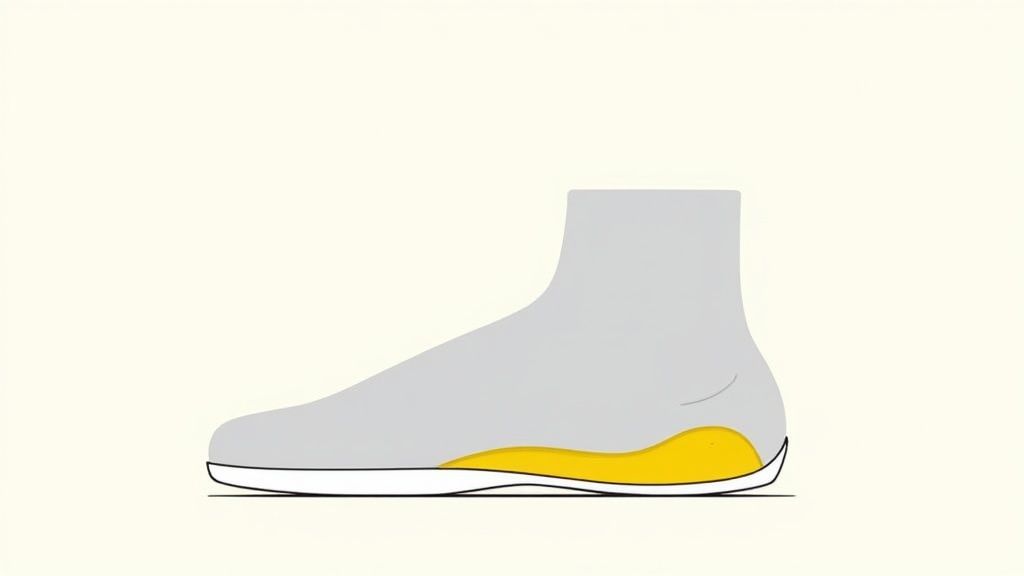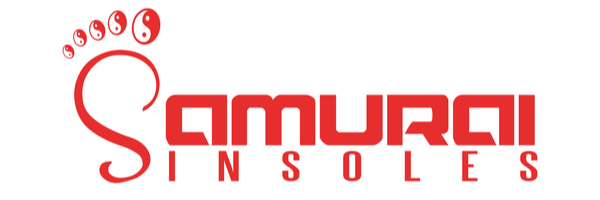What One Week of Plantar Fasciitis Recovery Really Looks Like

Let's be honest. The search for how to cure plantar fasciitis in one week is usually born out of desperation. That sharp, stabbing pain in your heel can make you willing to try almost anything for quick relief. While a complete, 100% cure in just seven days is a tall order for most, you absolutely can make significant, noticeable progress.
Think of this first week not as a magic trick, but as a critical bootcamp for your feet. It's all about learning the right recovery habits and building the discipline that lays the groundwork for getting rid of this pain for good.
Setting Realistic Expectations for Seven Days
The internet is full of quick-fix promises, but plantar fasciitis is an overuse injury. We're talking about inflammation and tiny tears in that thick band of tissue on the bottom of your foot. Healing damaged tissue simply requires time and consistent effort. Your personal recovery timeline depends heavily on a few things: how severe the pain is, how long you've been dealing with it, and how seriously you stick to the plan.
Someone who felt the first twinge after a single long run might feel worlds better in a week. But if you've been pushing through that nagging ache for months, you're dealing with a more chronic issue that will naturally take longer to calm down. You're not on this journey alone; an estimated 2 million Americans get treatment for this condition every year. It’s a common problem that rarely disappears overnight. The most proven approaches involve consistent care, not a one-and-done solution. You can explore more on plantar fasciitis statistics to see just how widespread it is.
Pain Management vs. True Healing
It’s so important to get the difference between feeling better temporarily and actually getting better. Popping an anti-inflammatory pill or icing your heel can definitely take the edge off. This is pain management, and it's useful for getting through your day. But it doesn't fix the source of the problem. It’s like hitting the mute button on a smoke detector instead of putting out the fire.
True healing is about repairing the damaged tissue of the plantar fascia. This happens when you do things that reduce strain and improve blood flow, like specific calf stretches, wearing supportive shoes, and giving your feet a real chance to rest. The pain is a signal from your body, and learning to listen is a big part of recovery. You can check out our guide on the exact location of plantar fasciitis pain to better understand what your foot is trying to tell you. This week, the goal is to shift from just silencing the pain to actively helping your body heal.
What Does Real Progress Feel Like?
If a total cure isn't the finish line for week one, what should you be looking for? Meaningful progress is all about noticing small but positive changes. Instead of expecting to leap out of bed pain-free on day eight, watch for these real-world signs that your efforts are paying off:
- Less intense morning pain: That first step out of bed might still be a bit stiff, but is it less of a shocking, sharp jab and more of a dull, manageable ache? That’s a huge win.
- You can stand for longer: Maybe last week, 10 minutes on your feet was your limit. If you can now get through a 20-minute task at the kitchen counter without wincing, you're making real progress.
- Bouncing back faster: After you’ve been on your feet for a while, does the pain go away more quickly with some rest and ice? A faster rebound time shows your foot is becoming more resilient.
- Reaching for pain relievers less often: If you find you're not automatically grabbing the ibuprofen bottle anymore, that's a direct sign that the underlying inflammation is decreasing.
- The tender spot is less tender: You know that one spot on your heel that feels agonizing to the touch? If pressing on it now just feels sore instead of sharp, that’s a clear indicator of healing.
Celebrating these small victories is key to staying motivated. They are proof that you're on the right track, reducing the strain on your plantar fascia and building positive momentum for the weeks ahead.
Your Daily Recovery Blueprint That Actually Works

Knowing you can make real progress in a week is one thing, but having a concrete plan is what makes it happen. This isn't a rigid, military-style schedule. Your life is unpredictable, and your pain level will have its good and bad days. The secret to learning how to cure plantar fasciitis in one week—or at least make a massive dent in the pain—is having an adaptable blueprint.
This roadmap is designed for real life. It centers on three critical windows: your morning, your workday, and your evening. By focusing your efforts on these key moments, you create an environment where your foot can actually start to heal.
Your Morning Kickstart Routine
That first step out of bed is often the most dreaded part of the day. The plantar fascia has been shortening and tightening all night, so that initial pressure can be excruciating. The entire point of your morning routine is to preempt that shock.
Before your feet even touch the floor, start with these simple movements while still in bed:
- Gentle Ankle Rolls: Slowly rotate your ankles clockwise 10 times, then counter-clockwise 10 times. This gently wakes up the joint and the surrounding tissues.
- Alphabet Writing: Pretend your big toe is a pen and write the alphabet in the air. It’s a simple way to move your foot through its full range of motion without any pressure.
- Pre-emptive Stretch: Keep a towel or resistance band by your bed. Loop it around the ball of your foot and gently pull your toes toward your body. You should feel a nice stretch in your calf and arch. Hold this for 30 seconds and repeat three times on each foot.
Finally, and this is a non-negotiable rule for the week: never walk barefoot first thing in the morning. Have a pair of supportive slippers or shoes waiting by your bed. Stepping onto a hard, cold floor is like a slap in the face to your already-irritated fascia.
Navigating Your Day at Work and Home
How you manage the middle of your day is just as critical. Your strategy here depends entirely on whether you're sitting at a desk or constantly on the move.
For those with desk jobs, your main enemy is the stiffness that comes from prolonged sitting.
- Roll It Out: Keep a frozen water bottle or a firm massage ball under your desk. For a few minutes every hour, roll your arch over it. This is a fantastic way to get a gentle massage and some inflammation-reducing cold therapy at the same time.
- Active Breaks: Set a timer on your phone for every 45 minutes. When it goes off, get up, walk around for a minute, and do a quick calf stretch against a wall. This keeps the fascia from tightening up again.
If you have an active job, your focus has to be on providing support and reducing the constant strain. Supportive footwear is your best friend. When you're always moving, your foot's mechanics are under a lot of stress, which can be made worse by issues like overpronation. This is especially true for people with flatter arches. To see what a difference targeted support can make, check out our guide on finding the right insoles for flat feet.
The Evening Wind-Down for Overnight Healing
What you do in the final hour before bed can significantly impact how you feel the next morning. Your goal here is to reduce the day's inflammation and prepare the fascia for a long period of rest.
- Ice Application: The most effective evening ritual is icing. Roll your foot over a frozen water bottle or apply an ice pack (wrapped in a thin towel) to your heel for 15-20 minutes. This directly targets the inflammation that has built up throughout the day.
- Final Stretches: Before you settle in, repeat the same towel and calf stretches you did in the morning. This helps to lengthen the fascia one last time before it has a chance to shorten while you sleep.
This simple routine helps break the cycle of overnight tightening and morning pain, setting you up for a better day tomorrow. To help you visualize how this works together, here is a sample daily schedule.
To help you see how these pieces fit together, here is a sample schedule. Think of it not as a strict set of rules, but as a framework for building your own daily recovery rhythm.
Daily Recovery Protocol Schedule Hour-by-hour breakdown of treatments, exercises, and rest periods for optimal healing throughout the week
| Time | Activity | Duration | Expected Outcome |
|---|---|---|---|
| 7:00 AM | In-Bed Stretches (Ankle Rolls, Towel Stretch) | 5-10 mins | Reduces morning stiffness and first-step pain. |
| 10:00 AM | Desk Foot Roll (Frozen Bottle) / Wall Stretch | 5 mins | Prevents mid-day stiffness and reduces inflammation. |
| 1:00 PM | Gentle Walk & Stretch Break | 10 mins | Improves blood flow and prevents fascia tightening. |
| 4:00 PM | Desk Foot Roll / Wall Stretch | 5 mins | Manages afternoon pain from accumulated stress. |
| 9:00 PM | Ice Heel & Final Stretches | 20-25 mins | Reduces inflammation and prepares fascia for overnight rest. |
The main takeaway here is consistency. These small, targeted actions throughout the day add up to big relief. Always listen to your body. If a stretch feels too painful, ease up. If your foot feels great, you might not need to ice as long. The goal is steady progress, not pushing through more pain.
Stretches That Target the Root Cause (Not Just Symptoms)

Making time in your day for stretching is a fantastic start, but the real progress comes from doing the right kind of stretches. Just going through the motions with that same old calf stretch from high school gym class simply won't be enough. To get real relief, you have to target the entire system that’s putting your plantar fascia under stress, not just the part that hurts the most. It’s all about being strategic.
Beyond the Basic Calf Stretch
We've all done the classic runner's lunge against a wall. While it’s not a bad stretch, it mostly hits the gastrocnemius, which is the large, easy-to-see muscle in your upper calf. The issue is that there's another critical muscle, the soleus, hidden underneath. This deeper muscle connects to the Achilles tendon much lower down, and that tendon feeds directly into your plantar fascia. Forgetting about the soleus is a very common mistake.
To properly stretch the soleus, you just need to make a small but significant change to the classic stretch:
- Bent-Knee Calf Stretch: Face a wall and place your hands on it for balance. Step one foot back.
- Instead of keeping that back leg straight, gently bend both of your knees. You'll feel the stretch move lower in your calf, much closer to your heel and Achilles tendon.
- Hold this for 30 seconds on each side. It's important not to bounce, as that can make the muscle tighten up in defense, which is the opposite of what we want. Aim for 3-4 repetitions on each leg.
Directly Addressing the Plantar Fascia
While tight calf muscles are a big piece of the puzzle, you also need to work on the fascia itself. The following techniques are perfect for tackling that awful morning stiffness and can even be done before your feet touch the floor. The aim is to gently lengthen the tissue after it has been in a shortened position all night.
-
The Seated Toe Pull: While sitting, cross your sore foot over the opposite knee. With one hand, gently pull all of your toes back toward your shin until you feel a good stretch along the arch of your foot. With your other hand, you can gently massage the tight, cord-like band of the fascia. Hold this for 20-30 seconds, and do it 3 times.
-
Self-Massage with a Ball: This is more of a release technique than a traditional stretch. Grab a firm ball (a lacrosse ball is perfect, but a golf ball or even a frozen water bottle will work) and sit down. Place the ball under your foot and roll it around your arch, applying as much pressure as you can comfortably handle. When you find a spot that’s especially tender, stop rolling and just hold the pressure there for about 15 seconds. This helps to release tiny knots and adhesions, improving your foot's flexibility.
A Quick Word on Consistency
These movements aren't just random; they're a specific sequence designed to undo the tension that leads to plantar fasciitis pain. If you truly want to figure out how to cure plantar fasciitis in one week, making these stretches a part of your morning and evening routine is non-negotiable. Always listen to your body. You want to feel a release or a "good" stretch, never a sharp or shooting pain. If something really hurts, back off a bit. Sticking with these specific movements will make a huge difference.
Smart Activity Management Without Going Stir-Crazy

Now that you have your stretches down, let's talk about the other 23 hours of your day. There's a common myth that you need to be completely off your feet to heal plantar fasciitis. The truth is, total inactivity can backfire, leading to more stiffness and a longer recovery. The real solution is smart activity management—making intelligent choices about how you move to help your body heal, not hurt it.
It's all about finding that happy medium between resting your foot and not losing your mind from boredom. This isn't about halting your life, but simply modifying it. Your most important new skill is learning to tell the difference between productive discomfort, like the feeling of a good stretch, and harmful pain—that sharp, stabbing sensation. That sharp pain is your body's emergency brake, and it’s critical that you listen when it tells you to stop.
Modifying Your Daily Grind
For most of us, taking a full week off from life isn't on the table. Whether you're working at a desk or on your feet all day, you can make small changes that add up to a huge difference in your pain levels.
If you have a desk job, your biggest enemy is sitting still for too long, which lets your plantar fascia tighten up. Try to get up every 30-45 minutes for a short walk to the water cooler or a quick calf stretch. This simple habit keeps blood flowing and helps you avoid that awful, sharp pain when you stand up after being seated for a while.
For those in physically demanding jobs, the focus isn't just on avoiding stiffness but on providing constant support. This is where supportive insoles stop being a nice-to-have and become an essential part of your work gear. Think of it this way: you wouldn't show up to a construction site without a hard hat. If you're standing all day, you shouldn't do it without proper arch support. Look for little moments to do micro-stretches, like a quick wall stretch while waiting for a machine to cycle. Every little bit helps.
Keeping Active Without Causing a Flare-Up
It’s incredibly frustrating to give up your workouts or feel like you can't even chase your kids around the yard. But you don’t have to sit on the sidelines. You just need to change your game plan.
For parents, this means being prepared for action. Instead of getting caught running barefoot after a toddler on hard floors, keep a pair of supportive house shoes or sneakers nearby for those unexpected sprints.
If you're an athlete or runner itching to get back out there, this is the perfect time to embrace cross-training.
- Swap High-Impact for Low-Impact: Give the pavement a break and try swimming, cycling, or using an elliptical machine. These activities keep your heart rate up without the repetitive pounding that irritates your feet.
- Focus on Core and Hip Strength: Believe it or not, weak hips can lead to bad running form, which is a common cause of plantar fasciitis. Use this time to build a stronger foundation so you come back more resilient.
- Listen to the Pain Scale: If you decide to test a light jog, rate your pain on a scale of 1-10. The moment it climbs above a 3, you need to stop. Pushing through the pain now will only set you back and make it impossible to cure plantar fasciitis in one week.
Ultimately, smart activity management is about being mindful. It’s about choosing the elevator over the stairs for a few days and, more importantly, celebrating the fact that you can stay active while giving your body the space it needs to heal.
Footwear and Support Systems That Make a Difference
Managing your activity levels is a huge part of recovery, but it’s only half the story if your feet are in the wrong environment. The shoes you wear can be your best friend or your worst enemy in this fight. It helps to think of your footwear less like a simple covering and more like a therapeutic tool that actively supports your foot while it heals.
Choosing the Right Everyday Shoes
Let's be clear: those flimsy, completely flat, or super-flexible shoes have to go on vacation for a while. Your healing foot is crying out for structure and stability. When you're out shopping, you need to become a detective looking for three key features: a firm heel counter (the part that cups your heel), good torsional stability, and a slight heel-to-toe drop.
A great way to test this is what I call the "dishrag test." If you can pick up a shoe and wring it out like a wet towel, put it back. It has no torsional stability. Shoes that are perfectly flat also force your plantar fascia to stretch with every single step, which is the last thing you want. The mission is to find footwear that controls bad motion and absorbs impact, not just something that feels cushy for a minute in the store.
The Power of Targeted Insoles and Supports
Sometimes, even a fantastic pair of shoes isn't quite enough, especially if your foot's natural mechanics are a big part of the problem. This is where orthotic insoles can feel like a miracle. Please don't confuse these with the squishy gel pads sold for "all-day comfort." A real orthotic provides structural support to fix issues like overpronation, where your arch collapses inward and puts massive strain on the fascia.
By controlling this motion, you're getting to one of the root causes of the pain. It’s a game-changer for many people. You can get a much better feel for how this works by reading our article that breaks down how plantar fasciitis insoles fix heel pain.
To help you weigh your options, here's a quick comparison of the different support systems available.
Footwear and Support Comparison Guide
Comparison of different shoe types, insoles, and support devices with effectiveness ratings and cost considerations
| Product Type | Effectiveness Rating | Cost Range | Best For |
|---|---|---|---|
| Supportive Shoes | High | $$ - $$$ | Daily wear to reduce overall strain and provide a stable foundation. |
| Orthotic Insoles | Very High | $$ - $$$$ | Correcting biomechanical issues like overpronation; can be moved between different pairs of shoes. |
| Night Splints | High | $ - $$ | Specifically targeting and preventing severe first-step pain in the morning. |
| Compression Socks | Medium | $ - $$ | Reducing daytime swelling, improving circulation, and providing general arch support. |
This table shows that while good shoes are fundamental, adding specific supports like orthotics or night splints targets different aspects of the problem for a more complete recovery plan.
Beyond Shoes: Night Splints and Compression
Your recovery efforts shouldn't stop just because your shoes are off. A night splint is a brilliantly simple device you wear while sleeping. It holds your foot in a gentle stretch, which prevents the plantar fascia from shortening and tightening up overnight. This directly fights that infamous first-step morning pain that can be so excruciating.
For relief during the day, especially if you're on your feet a lot, think about compression socks. They apply gentle, steady pressure that helps dial down swelling, improve blood flow, and give your arch a comforting, supported feeling that can make a long day much more manageable.
Investing in Your Recovery
It’s easy to hesitate when you see the price tag on some of these support systems. But you have to see this as a critical investment in your mission to cure plantar fasciitis in one week, or at the very least, get back on your feet much faster. A quality pair of insoles is often the most immediate, high-impact purchase you can make. If that stabbing morning pain is your biggest problem, a night splint is your next best bet. These aren't just nice-to-have accessories; they are essential tools for recovery.
Pain Management Beyond Popping Pills
When that sharp, stabbing heel pain flares up, it’s natural to want to reach for an anti-inflammatory pill. While NSAIDs like ibuprofen can take the edge off, think of them as a temporary patch—they quiet the pain alarm but don't fix the underlying fire. A better strategy involves tackling the inflammation head-on and giving your body the tools it needs to heal itself.
Mastering Cold and Heat Therapy
People often wonder whether to use ice or heat, but the answer is pretty simple: it all comes down to your goal at that moment.
Ice is your go-to for acute inflammation, especially after a long day when your heel is throbbing. By applying an ice pack (wrapped in a towel to protect your skin) or rolling your arch over a frozen water bottle for 15-20 minutes, you constrict the blood vessels. This directly dials down the swelling and gives you that sweet, numbing relief from the sharpest pain.
Heat, on the other hand, is for tackling stiffness and promoting blood flow. It’s the perfect morning ritual to perform before you do any of your stretches. Using a warm, damp towel or a heating pad for 10-15 minutes helps loosen up the tight, rigid plantar fascia, making those first few steps of the day much less shocking to your system. Just remember one crucial rule: never apply heat to a freshly swollen or aggravated heel, as it can make the inflammation worse.
Alternative and Topical Relief Strategies
You can also find relief by applying treatments directly to the source, bypassing the need to swallow a pill. Topical anti-inflammatory gels that contain diclofenac are a great option. They absorb through the skin to work on the painful tissue beneath, often with fewer systemic side effects. For a more natural approach, many people find arnica cream helps ease the soreness from the micro-tears in the fascia.
If you're looking for a more active approach, give contrast baths a try. This method uses quick temperature changes to create a "pumping" action in your blood vessels, which helps to flush out inflammation and bring in fresh, oxygen-rich blood to the area. It’s a powerful technique in your toolkit for figuring out how to cure plantar fasciitis in one week. Here’s the simple setup:
- Get two small tubs or basins, filling one with comfortably hot water and the other with cold water and a few ice cubes.
- Place your foot in the hot water for 3 minutes.
- Immediately move it to the cold water for 1 minute.
- Repeat this hot-cold cycle 4-5 times, making sure to end your session with the cold water.
This routine can make a significant difference in your pain levels. While these methods are effective, oral NSAIDs should really only be used for a few days at most to break a severe pain cycle. If your pain is severe, getting worse, or shows no sign of improving after a week of consistent self-care, it's a clear signal to check in with a healthcare professional.
Knowing When Self-Treatment Isn't Enough
You’ve been stretching, icing, and you’ve even swapped your flimsy flats for more supportive shoes. But what if that nagging heel pain just won’t quit? Recognizing when it’s time to call in a professional isn’t a sign of failure; it’s a smart move toward getting you back on your feet for good. While everyone secretly searches for how to cure plantar fasciitis in one week, the truth is that stubborn cases usually need an expert’s touch.
Red Flags You Can't Ignore
Your body is pretty good at sending signals when simple home care isn't cutting it. If any of these sound familiar, it’s probably time to book an appointment with a professional:
- Worsening Pain: Despite your best efforts, the pain is getting more intense or showing up more often.
- Nighttime Disturbances: The pain is sharp enough to wake you from a sound sleep.
- Unusual Sensations: You're feeling numbness, tingling, or pain that radiates up your leg, which could signal a nerve issue.
- A Progress Plateau: You’ve been consistent with your self-care for 7-10 days but have seen zero improvement.
- Acute Injury: You felt a sudden tearing or popping sensation, possibly with immediate bruising or swelling. This could be a rupture and requires urgent medical attention.
Who to See and What to Expect
While your primary doctor is a fine place to start, specialists like a podiatrist (a foot doctor) or a physical therapist will be your greatest allies in this fight. A podiatrist can give a definitive diagnosis, use imaging to rule out other problems like stress fractures, and discuss medical treatments like cortisone shots. A physical therapist, on the other hand, will design a personalized routine of exercises and stretches to correct the underlying mechanical issues that caused the pain in the first place.
It's also important to have realistic expectations about advanced treatments. For the most severe cases that don't respond to other care, surgery is sometimes considered. However, the average recovery for plantar fascia release surgery is about three and a half months before you can get back to your normal life. This shows that even a "surgical cure" is far from a quick fix. You can explore surgical recovery details here to learn more.
Building a Long-Term Prevention Plan
A good professional doesn't just treat the symptom; they help you build a long-term strategy to keep the pain from coming back. This involves digging into the root cause—was it your running form, those unsupportive shoes you wear to work, or maybe even tightness in your hip flexors? They can also guide you on managing pain without medication. Some people find great relief with cold therapy, and there are many documented ice bath benefits that a therapist might work into your plan.
A key part of any prevention strategy is making sure your feet have the right support, every single day. Instead of just masking the pain, you can help correct the underlying issue with every step you take. Samurai Insoles were designed in an orthotic lab to specifically combat overpronation, giving your plantar fascia the break it needs to finally heal and stay healthy.
Find your support at Samurai Insoles.



